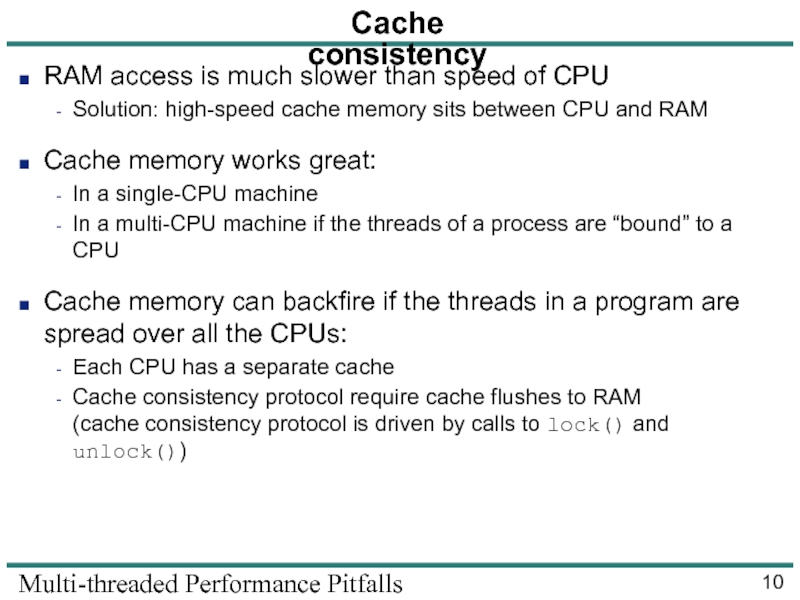- Главная
- Разное
- Дизайн
- Бизнес и предпринимательство
- Аналитика
- Образование
- Развлечения
- Красота и здоровье
- Финансы
- Государство
- Путешествия
- Спорт
- Недвижимость
- Армия
- Графика
- Культурология
- Еда и кулинария
- Лингвистика
- Английский язык
- Астрономия
- Алгебра
- Биология
- География
- Детские презентации
- Информатика
- История
- Литература
- Маркетинг
- Математика
- Медицина
- Менеджмент
- Музыка
- МХК
- Немецкий язык
- ОБЖ
- Обществознание
- Окружающий мир
- Педагогика
- Русский язык
- Технология
- Физика
- Философия
- Химия
- Шаблоны, картинки для презентаций
- Экология
- Экономика
- Юриспруденция
Multi-threaded performance. Pitfalls презентация
Содержание
- 1. Multi-threaded performance. Pitfalls
- 2. Multi-threaded Performance Pitfalls License Copyright © 2008
- 3. Multi-threaded Performance Pitfalls Purpose of this presentation
- 4. 1. A case study
- 5. Multi-threaded Performance Pitfalls Architectural diagram load balancing router ... DB
- 6. Multi-threaded Performance Pitfalls Architectural notes The customer
- 7. Multi-threaded Performance Pitfalls Strange problems were observed
- 8. 2. Analysis of the problems
- 9. Multi-threaded Performance Pitfalls What went wrong? Investigation
- 10. Multi-threaded Performance Pitfalls Cache consistency RAM access
- 11. Multi-threaded Performance Pitfalls Cache consistency (cont’) Overhead
- 12. Multi-threaded Performance Pitfalls Unfair mutex wakeup semantics
- 13. Multi-threaded Performance Pitfalls Unfair mutex wakeup semantics
- 14. Multi-threaded Performance Pitfalls Mutex optimization 1 Pseudo-code:
- 15. Multi-threaded Performance Pitfalls Mutex optimization 2 Assume
- 16. 3. Improving Throughput
- 17. Multi-threaded Performance Pitfalls Improving throughput 20X increase
- 18. 4. Finishing up
- 19. Multi-threaded Performance Pitfalls Recap: architectural diagram load balancing router ... DB
- 20. Multi-threaded Performance Pitfalls The case study is
- 21. Multi-threaded Performance Pitfalls Summary: important things to
Слайд 2Multi-threaded Performance Pitfalls
License
Copyright © 2008 Ciaran McHale.
Permission is hereby granted, free
of charge, to any person obtaining a copy of this
training course and associated documentation files (the “Training Course"), to deal in
the Training Course without restriction, including without limitation the rights to use,
copy, modify, merge, publish, distribute, sublicense, and/or sell copies of the Training
Course, and to permit persons to whom the Training Course is furnished to do so,
subject to the following conditions:
The above copyright notice and this permission notice shall be included in all copies
or substantial portions of the Training Course.
THE TRAINING COURSE IS PROVIDED "AS IS", WITHOUT WARRANTY OF ANY
KIND, EXPRESS OR IMPLIED, INCLUDING BUT NOT LIMITED TO THE
WARRANTIES OF MERCHANTABILITY, FITNESS FOR A PARTICULAR PURPOSE
AND NONINFRINGEMENT. IN NO EVENT SHALL THE AUTHORS OR
COPYRIGHT HOLDERS BE LIABLE FOR ANY CLAIM, DAMAGES OR OTHER
LIABILITY, WHETHER IN AN ACTION OF CONTRACT, TORT OR OTHERWISE,
ARISING FROM, OUT OF OR IN CONNECTION WITH THE TRAINING COURSE
OR THE USE OR OTHER DEALINGS IN THE TRAINING COURSE.
training course and associated documentation files (the “Training Course"), to deal in
the Training Course without restriction, including without limitation the rights to use,
copy, modify, merge, publish, distribute, sublicense, and/or sell copies of the Training
Course, and to permit persons to whom the Training Course is furnished to do so,
subject to the following conditions:
The above copyright notice and this permission notice shall be included in all copies
or substantial portions of the Training Course.
THE TRAINING COURSE IS PROVIDED "AS IS", WITHOUT WARRANTY OF ANY
KIND, EXPRESS OR IMPLIED, INCLUDING BUT NOT LIMITED TO THE
WARRANTIES OF MERCHANTABILITY, FITNESS FOR A PARTICULAR PURPOSE
AND NONINFRINGEMENT. IN NO EVENT SHALL THE AUTHORS OR
COPYRIGHT HOLDERS BE LIABLE FOR ANY CLAIM, DAMAGES OR OTHER
LIABILITY, WHETHER IN AN ACTION OF CONTRACT, TORT OR OTHERWISE,
ARISING FROM, OUT OF OR IN CONNECTION WITH THE TRAINING COURSE
OR THE USE OR OTHER DEALINGS IN THE TRAINING COURSE.
Слайд 3Multi-threaded Performance Pitfalls
Purpose of this presentation
Some issues in multi-threading are counter-intuitive
Ignorance
of these issues can result in poor performance
Performance can actually get worse when you add more CPUs
This presentation explains the counter-intuitive issues
Performance can actually get worse when you add more CPUs
This presentation explains the counter-intuitive issues
Слайд 6Multi-threaded Performance Pitfalls
Architectural notes
The customer felt J2EE was slower than CORBA/C++
So,
the architecture had:
Multiple J2EE App Servers acting as clients to…
Just one CORBA/C++ server that ran on an 8-CPU Solaris box
The customer assumed the CORBA/C++ server “should be able to cope with the load”
Multiple J2EE App Servers acting as clients to…
Just one CORBA/C++ server that ran on an 8-CPU Solaris box
The customer assumed the CORBA/C++ server “should be able to cope with the load”
Слайд 7Multi-threaded Performance Pitfalls
Strange problems were observed
Throughput of the CORBA server decreased
as the number of CPUs increased
It ran fastest on 1 CPU
It ran slower but “fast enough” with moderate load on 4 CPUs (development machines)
It ran very slowly on 8 CPUs (production machine)
The CORBA server ran faster if a thread pool limit was imposed
Under a high load in production:
Most requests were processed in < 0.3 second
But some took up to a minute to be processed
A few took up to 30 minutes to be processed
This is not what you hope to see
It ran fastest on 1 CPU
It ran slower but “fast enough” with moderate load on 4 CPUs (development machines)
It ran very slowly on 8 CPUs (production machine)
The CORBA server ran faster if a thread pool limit was imposed
Under a high load in production:
Most requests were processed in < 0.3 second
But some took up to a minute to be processed
A few took up to 30 minutes to be processed
This is not what you hope to see
Слайд 9Multi-threaded Performance Pitfalls
What went wrong?
Investigation showed that scalability problems were caused
by a combination of:
Cache consistency in multi-CPU machines
Unfair mutex wakeup semantics
These issues are discussed in the following slides
Another issue contributed (slightly) to scalability problems:
Bottlenecks in application code
A discussion of this is outside the scope of this presentation
Cache consistency in multi-CPU machines
Unfair mutex wakeup semantics
These issues are discussed in the following slides
Another issue contributed (slightly) to scalability problems:
Bottlenecks in application code
A discussion of this is outside the scope of this presentation
Слайд 10Multi-threaded Performance Pitfalls
Cache consistency
RAM access is much slower than speed of
CPU
Solution: high-speed cache memory sits between CPU and RAM
Cache memory works great:
In a single-CPU machine
In a multi-CPU machine if the threads of a process are “bound” to a CPU
Cache memory can backfire if the threads in a program are spread over all the CPUs:
Each CPU has a separate cache
Cache consistency protocol require cache flushes to RAM (cache consistency protocol is driven by calls to lock() and unlock())
Solution: high-speed cache memory sits between CPU and RAM
Cache memory works great:
In a single-CPU machine
In a multi-CPU machine if the threads of a process are “bound” to a CPU
Cache memory can backfire if the threads in a program are spread over all the CPUs:
Each CPU has a separate cache
Cache consistency protocol require cache flushes to RAM (cache consistency protocol is driven by calls to lock() and unlock())
Слайд 11Multi-threaded Performance Pitfalls
Cache consistency (cont’)
Overhead of cache consistency protocols worsens as:
Overhead
of a cache synchronization increases
(this increases as the number of CPUs increase)
Frequency of cache synchronization increases (this increases with the rate of mutex lock() and unlock() calls)
Lessons:
Increasing number of CPUs can decrease performance of a server
Work around this by:
Having multiple server processes instead of just one
Binding each process to a CPU (avoids need for cache synchronization)
Try to minimize need for mutex lock() and unlock() in application
Note: malloc()/free(), and new/delete use a mutex
Frequency of cache synchronization increases (this increases with the rate of mutex lock() and unlock() calls)
Lessons:
Increasing number of CPUs can decrease performance of a server
Work around this by:
Having multiple server processes instead of just one
Binding each process to a CPU (avoids need for cache synchronization)
Try to minimize need for mutex lock() and unlock() in application
Note: malloc()/free(), and new/delete use a mutex
Слайд 12Multi-threaded Performance Pitfalls
Unfair mutex wakeup semantics
A mutex does not guarantee First
In First Out (FIFO) wakeup semantics
To do so would prevent two important optimizations (discussed on the following slides)
Instead, a mutex provides:
Unfair wakeup semantics
Can cause temporary starvation of a thread
But guarantees to avoid infinite starvation
High speed lock() and unlock()
To do so would prevent two important optimizations (discussed on the following slides)
Instead, a mutex provides:
Unfair wakeup semantics
Can cause temporary starvation of a thread
But guarantees to avoid infinite starvation
High speed lock() and unlock()
Слайд 13Multi-threaded Performance Pitfalls
Unfair mutex wakeup semantics (cont’)
Why does a mutex not
provide fair wakeup semantics?
Because most of the time, speed matter more than fairness
When FIFO wakeup semantics are required, developers can write a FIFOMutex class and take a performance hit
Because most of the time, speed matter more than fairness
When FIFO wakeup semantics are required, developers can write a FIFOMutex class and take a performance hit
Слайд 14Multi-threaded Performance Pitfalls
Mutex optimization 1
Pseudo-code:
void lock()
{
if (rand() % 100)
< 98) {
add thread to head of list; // LIFO wakeup
} else {
add thread to tail of list; // FIFO wakeup
}
}
Notes:
Last In First Out (LIFO) wakeup increases likelihood of cache hits for the woken-up thread (avoids expense of cache misses)
Occasionally putting a thread at the tail of the queue prevents infinite starvation
Notes:
Last In First Out (LIFO) wakeup increases likelihood of cache hits for the woken-up thread (avoids expense of cache misses)
Occasionally putting a thread at the tail of the queue prevents infinite starvation
Слайд 15Multi-threaded Performance Pitfalls
Mutex optimization 2
Assume several threads concurrently execute the following
code:
for (i = 0; i < 1000; i++) { lock(a_mutex); process(data[i]); unlock(a_mutex); }
A thread context switch is (relatively) expensive
Context switching on every unlock() would add a lot of overhead
Solution (this is an unfair optimization):
Defer context switches until the end of the current thread’s time slice
Current thread can repeatedly lock() and unlock() mutex in a single time slice
for (i = 0; i < 1000; i++) { lock(a_mutex); process(data[i]); unlock(a_mutex); }
A thread context switch is (relatively) expensive
Context switching on every unlock() would add a lot of overhead
Solution (this is an unfair optimization):
Defer context switches until the end of the current thread’s time slice
Current thread can repeatedly lock() and unlock() mutex in a single time slice
Слайд 17Multi-threaded Performance Pitfalls
Improving throughput
20X increase in throughput was obtained by combination
of:
Limiting size of the CORBA server’s thread pool
This Decreased the maximum length of the mutex wakeup queue
Which decreased the maximum wakeup time
Using several server processes (each with a small thread pool) rather than one server process (with a very large thread pool)
Binding each server process to one CPU
This avoided the overhead of cache consistency
Binding was achieved with the pbind command on Solaris
Windows has an equivalent of process binding:
Use the SetProcessAffinityMask() system call
Or, in Task Manager, right click on a process and choose the menu option (this menu option is visible only if you have a multi-CPU machine)
Limiting size of the CORBA server’s thread pool
This Decreased the maximum length of the mutex wakeup queue
Which decreased the maximum wakeup time
Using several server processes (each with a small thread pool) rather than one server process (with a very large thread pool)
Binding each server process to one CPU
This avoided the overhead of cache consistency
Binding was achieved with the pbind command on Solaris
Windows has an equivalent of process binding:
Use the SetProcessAffinityMask() system call
Or, in Task Manager, right click on a process and choose the menu option (this menu option is visible only if you have a multi-CPU machine)
Слайд 20Multi-threaded Performance Pitfalls
The case study is not an isolated incident
The project’s
high-level architecture is quite common:
Multi-threaded clients communicate with a multi-threaded server
Server process is not “bound” to a single CPU
Server’s thread pool size is unlimited (this is the default case in many middleware products)
Likely that many projects have similar scalability problems:
But the system load is not high enough (yet) to trigger problems
Problems are not specific to CORBA
They are independent of your choice of middleware technology
Multi-core CPUs are becoming more common
So, expect to see these scalability issues occurring more frequently
Multi-threaded clients communicate with a multi-threaded server
Server process is not “bound” to a single CPU
Server’s thread pool size is unlimited (this is the default case in many middleware products)
Likely that many projects have similar scalability problems:
But the system load is not high enough (yet) to trigger problems
Problems are not specific to CORBA
They are independent of your choice of middleware technology
Multi-core CPUs are becoming more common
So, expect to see these scalability issues occurring more frequently
Слайд 21Multi-threaded Performance Pitfalls
Summary: important things to remember
Recognize danger signs:
Performance drops as
number of CPUs increases
Wide variation in response times with a high number of threads
Good advice for multi-threaded servers:
Put a limit on the size of a server’s thread pool
Have several server processes with a small number of threads instead of one process with many threads
Bind each a server process to a CPU
Wide variation in response times with a high number of threads
Good advice for multi-threaded servers:
Put a limit on the size of a server’s thread pool
Have several server processes with a small number of threads instead of one process with many threads
Bind each a server process to a CPU


























